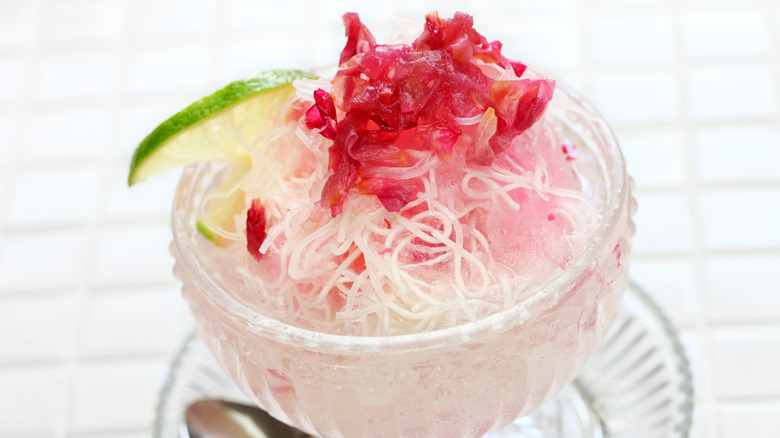How Persians Made Ice Cream In The Desert Hundreds Of Years Before The Freezer Was Invented
When dreaming of ice cream, it's easy to picture sleek, colorful ice cream shops with scoops of chocolate chip, mint, or double fudge delights piled high. Those all require modern freezers, metal scoops, and (preferably) a sugar cone thrown into the mix. We take all that for granted these days, but ice cream as we know it hasn't actually been around very long, relatively speaking. That doesn't mean older civilizations weren't craving icy-cold sweet treats on hot summer days.
As it happens, a primitive form of ice cream has deep roots in Persian deserts dating back to at least 400 B.C., more than 2,000 years ago. And we do mean deep roots — as in, subterranean chambers and underground aqueducts. That's what it took when ancient Persians wanted sweet relief from desert heat.
A lot of clever engineering skills were employed when creating early ice cream, which reportedly resembled semi-frozen sorbet or granita more than the dairy-based creams of today. With no refrigeration and no freezers, they harnessed the gifts of nature instead, using wind, water, ice, and shallow pools to create "natural refrigerators." This impressive cooling system allowed for storage in massive dome-shaped ice towers called yakhchals, built with thick mud bricks and cemented with a rudimentary but very effective form of mortar called "sarooj." Water flowed into shallow pools within shaded enclosures, freezing in low temperatures on cold winter nights.
Modern versions of ancient ice cream
As if an ancient underground refrigeration system weren't impressive enough, early Persian frozen desserts also excelled in creating flavors and textures. Though a precursor to modern ice cream, these chilly treats had little resemblance to today's version. Many would venture to say we digressed, at least in the ingenuity, fragrance, and textural nuances of what's now called faloodeh in modern-day Iran.
Brace yourself for this, and momentarily put aside those visions of cookies-and-cream or Cherry Garcia. Faloodeh, also spelled faludeh, is a semi-frozen icy dessert made with rose water, sugar, lime juice, and cooked rice vermicelli (which is one of several delicious types of rice noodles). Though somewhat unusual for Western palettes, these noodles aren't thick or doughy; rather, they were thin, delicate, and translucent. In faloodeh, the noodles are cooked thoroughly, not left al dente, so they'll soak up the lime and rose water syrup and become crunchy during the freezing process.
Way back when, the ingredients reportedly included honey, mashed fruit, saffron, and other spices. All those things can be incorporated into modern iterations, but the noodles aren't negotiable; they remain core to genuine faloodeh. This ages-old version of ice cream commonly appears in Iran's bastani shops, similar to ice cream parlors in America. Typical toppings range from crushed pistachios to sour cherries, crushed mint, and extra lime juice or lime wedges. There's still no dairy involved in faloodeh, but Iranian bastani shops routinely serve traditional saffron ice cream as well. It's worth mentioning that this dessert has various interpretations in other countries, along with alternate spellings and varied origin stories.

